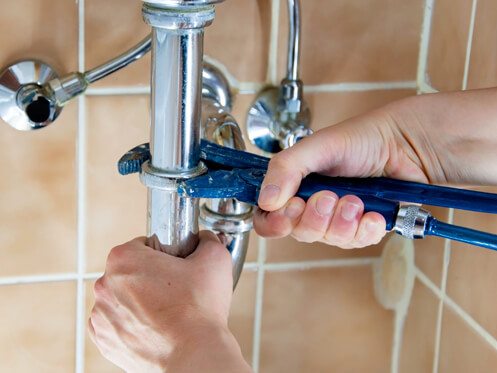
When you call a plumbing repair technician to help with a problem, it’s fairly common for them to report that they tightened up some loose fixtures. However, while the idea of plumbing fixtures loosening over time seems logical, few people are aware of why this happens. Since plumbing can seem so stable, it might seem a bit odd to think about your pipes and fixtures gradually getting loose. Understanding why this happens can help you better understand your plumbing situation.
Do Plumbing Fixtures Really Get Loose?
First of all, it can be helpful to clear up some misunderstandings. Some people think that the idea of fixtures loosening over time is false. They assume that this concept is just used to cover up shoddy workmanship in the past. However, the reality is that loosening fixtures is definitely possible.
Almost all fixtures are installed with some version of a screw. Without getting into all of the complicated physics behind screws, the problem is essentially that a screw is in a state of high tension. It takes more force to tighten a screw, but the screw naturally loses some of its tension over time. This means that instead of holding your fittings firmly together, it gradually loosens. Any time anything wiggles your plumbing fixture, the screw will loosen just a minuscule amount. Over time, this can have a significant effect on your plumbing.
Even if a fixture is installed correctly, it will eventually become loose. This usually takes quite a while. A properly installed fixture should not become loose for at least five to 10 years depending on the fixture type. However, if the fixture is installed incorrectly, it might get loose even quicker. You may notice that the fixture has worked its way loose in as little as six months.
Reasons that Plumbing Fixtures Can Get Loose Over Time
Ultimately, loose plumbing fixtures tend to happen because of some sort of motion jarring the screws, nuts, and bolts that hold them in place. Many plumbing experts believe that the main problem is simply vibration. As you walk around and use your home, vibrations end up traveling through the floors and up the walls. These little motions gradually push the fixtures, clamps, and screws out of alignment, causing things to loosen up. Unfortunately, this reason for loose plumbing fixtures is unavoidable. Things will get loose eventually.
Especially in older homes, a common issue is the house settling. The land gradually shifts over time, so eventually, everything in your house starts to get a little crooked. As floors slope, your plumbing can warp a little. Shifting is not enough to cause major leaks in a properly installed plumbing system. However, it does put a little more strain on your pipes. Over time, it becomes easier for items to work their way loose.
The final cause of loose plumbing fixtures is natural wear and tear. This sort of loosening is especially notable on the handles of fixtures. Each time you use a faucet or flush a toilet, you are putting pressure on parts of the fixture that use rubber seals. The back and forth motion slowly wears down seals until items eventually become loose. Furthermore, if you are somewhat rough with your fixtures, you can cause their bolts and screws to loosen a little faster. This is why you might notice that frequently used fixtures, like the kitchen faucet, tend to loosen up first.
Are Loose Fittings a Problem?
If loose plumbing fixtures happen naturally, should you worry? Though this plumbing problem is commonplace, it is still an issue. At first, loose fixtures might just be annoying. You might have to jiggle the handle a little to get the amount of hot water you want, or your faucet might drip for a minute or two after you turn it off.
However, over time, loose fixtures turn into a bigger plumbing problem. Depending on where the fixture is, a loose fixture can cause leaks to happen. Furthermore, loose fixtures tend to end up making your faucet, spouts, and handles unstable. One day, they can just fall off, injuring a user or causing other issues.
How to Tell if Your Older Fixtures Are Loose
Since the damage happens over time, it can be tricky to tell when an older fixture gets loose. The effects can be different depending on which fixture gets loose. If you have a loose fitting where the fixture attaches to the pipe, you can end up with a silent leak. There may be some minor signs, like a higher than usual water bill and reduced water pressure throughout your home. However, you may not notice an issue until your walls, ceilings, or floor become damp and moldy.
In some cases, loose fittings can result in odd noises. As pipes and plumbing fixtures get looser, they can rub against each other. Depending on the materials used in your house, this may result in rattling, squeaking, or groaning noises. Typically, the sounds will be worse when you are actively using the fixtures. However, there is a chance that they may still make weird noises when your water is not even turned on.
Most people worry about fixtures getting loose around points of entry, such as faucets or showerheads. However, you can also have loose fittings in drains. This can be a big problem. When these fittings are loose, your drainage material will seep below your bath or into your floor each time you use a drain. You may notice foul odors or strange spots of discoloration.
What You Can Do to Reduce the Risk of Loosening Plumbing Fixtures
If you do not want loose plumbing fixtures, the solution is not as easy as just tightening it harder when you install it. In fact, overtightening can actually contribute to loosening. It tends to strip the threads on your bolts or washers, so they lose their grip more easily. To keep your plumbing fixtures as stable as possible, it is more important to pay close attention to installation.
A knowledgeable plumbing installation professional will take several steps to reduce loosening. First, they will align your fixtures correctly. This ensures that a slightly crooked fixture does not slip out of place more evenly. Depending on your fixture, the plumbing technician will also use things like washers. These are thin metal rings that help to compensate for minor gaps in a bolt. They use a spring-like action to help lock your bolts and screws into place, so your fixtures remain more stable.
To keep your plumbing fixtures in optimal condition, they need to be installed and maintained by a professional. At Beyer Plumbing, we have the expertise needed to install your plumbing as securely as possible. We also help San Antonio residents with a variety of other plumbing services, including repairs, installations, and maintenance. When you want the best HVAC service possible, give us a call and schedule an appointment.


